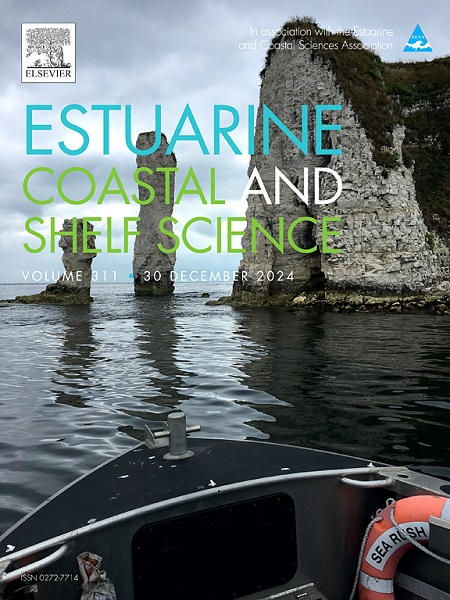Clam diet and production in relation to the spatial pattern of food source inputs and quality: A stable isotope approach
IF 2.6
3区 地球科学
Q1 MARINE & FRESHWATER BIOLOGY
引用次数: 0
Abstract
We used four stable isotopes to determine the spatial variability in the diet of Mya arenaria in the Plum Island Sound estuary, Massachusetts, USA and compared diet to the production rate of dietary food sources. Clams were collected for a year along the estuary and their diet determined at each site with four stable isotopes, δ13C, δ15N, δ34S and δ2H, using the Bayesian mixing model (MixSIAR). We compared diet composition and its quality to patterns of clam production. The results showed that M. arenaria depended on locally produced organic matter, the availability of which varied along the estuary. For the lower estuary, the dominant food source for clams was ocean/estuarine unicellular algal particulate organic matter followed by salt marsh detritus. Brackish and riverine organic matter sources were of secondary importance. For the upper estuary, the relative importance of brackish marsh and riverine organic matter increased. The net inputs of organic matter from the river, tidal marshes and unicellular algae were closely matched with the dietary composition of clams. The down estuary pattern of increasing clam productivity was best predicted by a similar pattern in suspended particulate organic matter quality as indicated by the ratio of C:N. The C:N ratio decreased from about 10.5:1 to 7.4:1 along the region of clam growth. We also found that δ2H was a useful tracer, effectively discriminating between marsh-derived and aquatic algae-derived organic matters and significantly increasing the predictive power and reliability of the mixing model. Our study provides fundamental knowledge on suitable habitats for the M. arenaria growth in the Plum Island estuary and insights into selecting stable isotopes for elucidating feeding ecology and trophic dynamics of estuarine organisms.

求助全文
约1分钟内获得全文
求助全文
来源期刊
CiteScore
5.60
自引率
7.10%
发文量
374
审稿时长
9 months
期刊介绍:
Estuarine, Coastal and Shelf Science is an international multidisciplinary journal devoted to the analysis of saline water phenomena ranging from the outer edge of the continental shelf to the upper limits of the tidal zone. The journal provides a unique forum, unifying the multidisciplinary approaches to the study of the oceanography of estuaries, coastal zones, and continental shelf seas. It features original research papers, review papers and short communications treating such disciplines as zoology, botany, geology, sedimentology, physical oceanography.

 求助内容:
求助内容: 应助结果提醒方式:
应助结果提醒方式:


